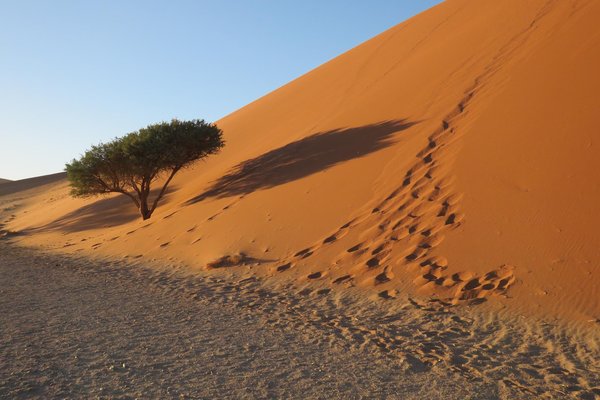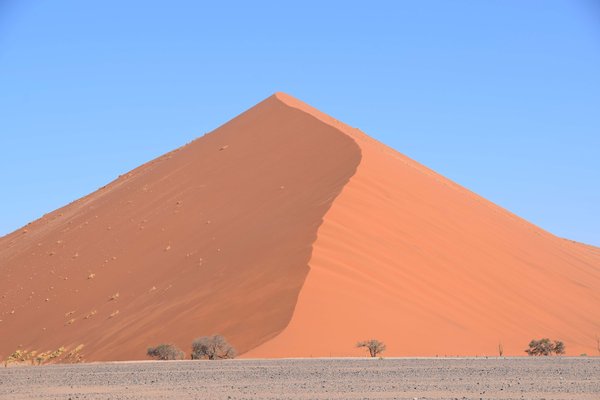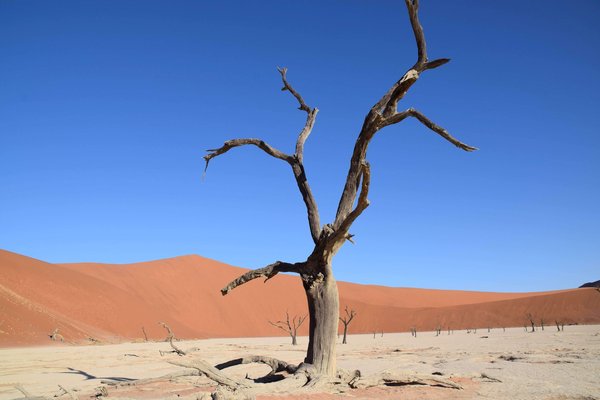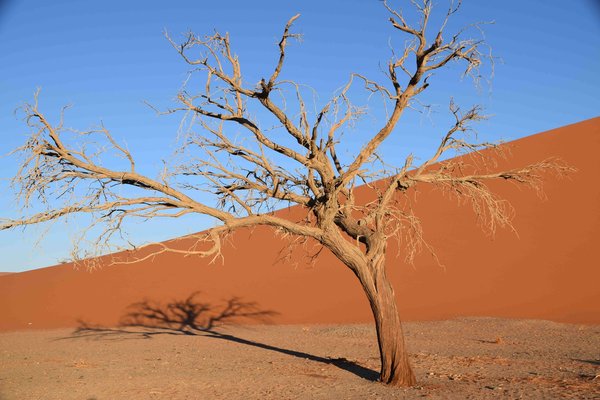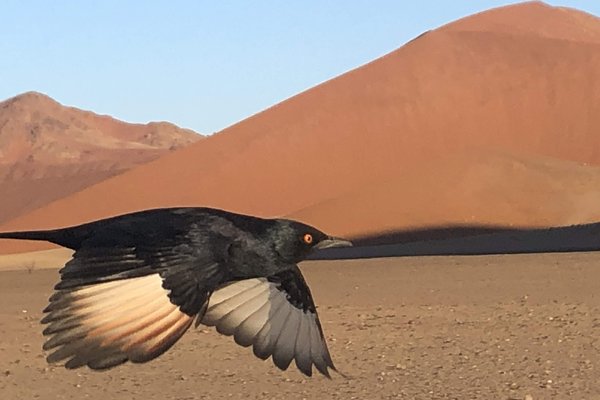Namibia
Namib Sand Sea
The Namib Sand Sea is a coastal fog desert with extensive dune fields of high natural beauty.
Sand is carried and deposited here from afar, resulting in numerous coloured dune fields with massive shifting dunes. It is the habitat of several endemic invertebrate animals that have adapted to life in a hyper-arid desert environment and use fog as their primary source of water. The Namib Sand Sea is part of Namib-Naukluft Park.
Community Perspective: This is where the gecko licked its own eyeballs in David Attenborough’s ‘Planet Earth II: Deserts’. It’s the number 1 attraction of Namibia, best known for the spectacular beauty of the Sossusvlei and Dead Vlei.
Site Info
Official Information
- Full Name
- Namib Sand Sea (ID: 1430)
- Country
- Namibia
- Status
-
Inscribed 2013
Site history
History of Namib Sand Sea
- 2013: Inscribed
- Inscribed
- Type
- Natural
- Criteria
- vii
- viii
- ix
- x
Links
- UNESCO
- whc.unesco.org
- Official
-
- nwr.com.na — Namib Naukluft Park
All Links
UNESCO.org
- whc.unesco.org — whc.unesco.org/
Official Website
- nwr.com.na — Namib Naukluft Park
News Article
- Jan. 21, 2017 newscientist.com — Mysterious fairy circles in Namibian desert explained at last
Community Information
- Community Category
- Natural landscape: Desert
Travel Information
Recent Connections
-
Works by Thomas Pynchon
"He rode her all over the territory. Fr…
-
Perfect Inscriptions
2013 -
Yardangs
The nom file states that yardangs are p…
Connections of Namib Sand Sea
- Geography
-
-
Atlantic Ocean
-
Canyons
Kuiseb Canyon
-
- Trivia
- History
-
-
Shell Mounds (Middens)
At Sandwich Harbour and Sylvia Hill (nom file)
-
- Ecology
-
-
Living Fossils
welwitschiaSee en.wikipedia.org
-
Ratites
common ostrich -
Endemic Bird Species
Dune Lark (Certhilauda erythrochlamys) -
Lagoons
Sandwich Harbour -
Fog drip
Crit IX: a coastal fog desert where plant and animal communities are continuously adapting to life in a hyper arid environment. Fog serves as the primary source of water ... -
Dunes
encompassing a diverse array of large, shifting dunes -
Seals
fur seals -
Salt Flats
Sossusvlei -
Yardangs
The nom file states that yardangs are present in small numbers (p. 106) -
Hyper-arid
"Criterion (ix): ... where plant and animal communities are continuously adapting to life in a hyper arid environment" (OUV) -
Inselbergs
The sand sea includes most known types of dunes together with associated landforms such as inselbergs (OUV statement)
-
Ergs
Numerous mentions in the Nom File. eg "The ephemeral water courses flowing into the erg form oases sparsely marked by trees"
-
- World Heritage Process
-
-
Perfect Inscriptions
2013 -
Inscribed on all 4 Natural criteria
-
Natural sites filling gaps cited by IUCN
Namib and Kalahari deserts habitat -
Upstream process
Pilot project on the South Namib Erg (part of Namib Sand Sea inscription)
-
- Human Activity
-
-
Natural sites with indigenous human population
Topnaars (Nama)
-
- WHS on Other Lists
-
-
IUGS Geological Heritage Sites
Namib Sand Sea -
Ramsar Wetlands
Sandwich HarbourSee www.ramsar.org
-
- Timeline
-
-
Cretaceous
Having endured arid or semi-arid conditions for roughly 55-80 million years, the Namib is also the oldest desert in the world. (wiki)
-
- Visiting conditions
-
-
Foreigner prices
Naukluft Park: 30 Namibian dollar for Namibian nationals, 60 Namibian dollar for SADC residents (14 other Southern African states) and 80 Namibian dollar for other nationalities.
-
- Literature & Film
-
-
Works by Thomas Pynchon
"He rode her all over the territory. From the coastal desert to the Kalahari, from Warmbad to the Portuguese frontier..." (V., pg. 240).
-
Location for a classic movie
2001: A Space Odyssey - "a 1968 epic science-fiction film produced and directed by Stanley Kubrick" (according to nom file) (preserved in the US National Film Registry)
-
News
- newscientist.com 01/21/2017
- Mysterious fairy circles in Namibi…
Recent Visitors
Visitors of Namib Sand Sea
- AC
- AK
- Alexander Barabanov
- alicemears
- A. Mehmet Haksever
- Aspasia
- Atila Ege
- AustralLights
- bergecn
- Bernard Joseph Esposo Guerrero
- Bill Maurmann
- Bodil Ankerly
- Bram de Bruin
- brornt
- Carlo Sarion
- chapnis
- chiuliqi
- Christoph
- Claire Bradshaw
- Colossus
- Csaba Nováczky
- Cyberczar
- Deffra
- Elaine McArdle
- Elf21
- Els Slots
- Emili Xaus
- Erfe91
- Erik Jelinek
- Eva Kisgyorgy
- Fam39
- Fan Yibo
- Felicité
- Fernweh
- Fmaiolo@yahoo.com
- Gary Arndt
- Geert Luiken
- Gernot
- Hammeel
- Harald T.
- Harry Mitsidis
- H Beswick
- Iain Jackson
- IreneKD
- Jacob Otten
- janameerman
- Janos
- Javier Coro
- Jawnbeary
- Jay T
- Jean Lecaillon
- Jon Eshuijs
- Joyce van Soest
- Kbecq
- Krijn
- Liamps91
- Loic Pedras
- Lucio
- Ludvan
- Luis Filipe Gaspar
- Lukasz Palczewski
- lynnz317@aol.com
- Maja
- Malgorzata Kopczynska
- marcel staron
- Mariam
- Marlies van Wolfswinkel
- Martin
- MAURO PODDA PANI
- Michael Novins
- Michael Turtle
- Mikko
- MMM
- Monica66
- MoPython
- Morodhi
- Mozzer76
- Mtlmr
- Niall Sclater
- Nicole Lampos
- Nihal Ege
- Patrik_globe
- Philipp Leu
- Pieter Dijkshoorn
- Piotr Wasil
- Randi Thomsen
- Reiseblitz
- Reisedachs
- Roger Ourset
- Roman Bruehwiler
- Rosemary
- Sandra!
- Sergio Arjona
- Solivagant
- Stanislaw Warwas
- stephhollett
- SteveD92
- Sutul
- Svein Elias
- Szabolcs Mosonyi
- Tamara Ratz
- Tatiana Nikulnikova
- Thomas Buechler
- Thomas van der Walt
- Timothy C Easton
- Tinamu
- tony0001
- Vanessa Buechler
- Vernon Prieto
- Walter
- Waxwing
- yasdeb
- Yongcheng Liu
- Zizmondka
- Zoë Sheng
- Zsuzsanna Forray
Community Reviews
Show full reviews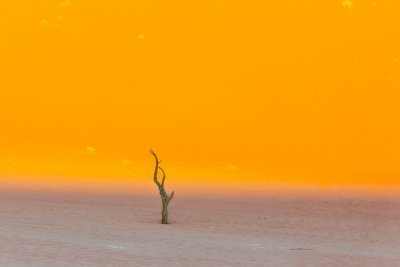
I visited this site in the summer (Dec 2015) as part of an organised tour to Etosha Pan (Etosha NP) and Sossusvlei (Namib-Naukluft NP). This was one of the best travel experiences I've had, despite the oppressive summer heat (this was supposed to happen in winter, Jul 2015, with a friend who made this trip possible). While this trip was a decade ago, I hope readers will pick something useful from this review of my 2-night trip to Sossusvlei.
Day 1 - Flying to Kulala
I flew from Hosea Kutako (Windhoek) Airport to Kulala Desert Lodge, which is located within the boundary of the national park. The late-morning flight gave a great introduction to the arid Martian-like landscape. Upon arrival, we went straight to the lodge to take shelter from the heat. There was a small pool outside of the dining area to cool off, though I spent the early afternoon eating and just enjoying the breezy thatch-roofed accommodation. Our first activity went on late in the afternoon, which involved driving around the desert, walking around rocky hills, and having a wee picnic while watching the sunset. One advantage of travelling during summer was the longer days, so if organised tours have fixed timings for activities throughout the year, you'd get extra hours of sunshine. Anyway, the sunset was pure magic! It was accompanied by the changing colours of the dunes and sky, from bright yellow to orange to pink and then purple until the stars came out.
… Keep reading 0 comments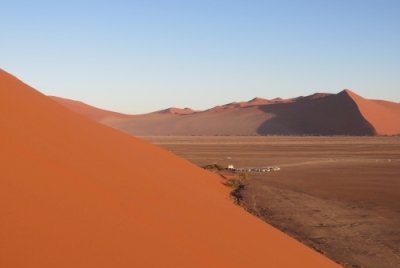
The Namib Sand Sea is the most extensive example in the world of a coastal fog desert. It’s the kind of place nature documentaries rely upon. In David Attenborough’s ‘Planet Earth II: Deserts’ several scenes were filmed here such as the gecko licking its own eyeballs - where thaw had formed in the early morning - to get liquid. The site was inscribed on all 4 natural criteria and it is the undoubted highlight of a trip to Namibia.
The designated area is enormous – about 75% of the size of the Netherlands. But only a small part of it is open to regular tourists. The common access point is at the east, at Sesriem and the Sossusvlei. Only a few tour operators have permits to venture deeper into the Namib Sand Sea (they are named in the nomination dossier).
We stayed overnight at the Sossus Dune Lodge, which is the only hotel within the park’s borders (there’s a campsite as well which has this privilege). This means that you’ll be in the park before sunrise and have all the nice spots to yourself for at least an hour or so. At 5.30 a.m. we were the first to start the climb of Dune 45, at 150m the highest of the red sand dunes along the Sossusvlei access road. Sitting at the top ridge we watched the sunrise, giving the surrounding dunes a deep red colour. Getting down from a sand dune of this height also is great …
Keep reading 0 comments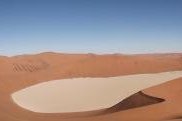
The most well known part of the Namib desert/Namib sand sea are its salt/clay pans such as Sossusvlei & Deadvlei.
However, from the park gates to Sossusvlei it is an approx. 70 km drive through the dunes (for 65 km on a tarred road). If you are at the gates by sunrise these orange dunes are a stunning sight.
Also the 'vleis' (especially Deadvlei) are magical with white salt/clay, black trees, orange dunes and a blue sky.
One of the most beautiful places we have visited...
Keep reading 0 comments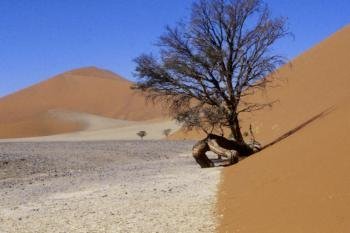
I was suprised no one has reviewed this site yet, as it is considered the number one destination in Namibia. I visited the area back in 1996.
The « Namib Sand Sea » is a huge desert of sand dunes blocked between the semi-arid plains in the east and the cold atlantic ocean in the west. On an independant basis, the Sossusvlei area is the easiest to visit. Nowaday, I’ve read that there can be long lines to enter the park. Back in 1996, it was a solitary place.
Sossusvlei is a magnificiant and magical area. A road, now tarred, is following a large white salt and clay pan deep into the sand sea. All around are numerous high pink dunes, some being more than 300 meters high. It is a photographer’s paradise.
The road follows the bed of the Tsauchab river. The harsh and dry desert conditions prevent the river to flow, and the river bed is almost always dry. The road from the park entrance (in a settlement called Sesriem) to Sossusvlei is 60 km long. The last 5 km requires a 4x4 drive. For fit people, and with plenty of water (2 liters per person), it is pleasant to walk those last 5 km to Sossusvlei. It seems that there is now a shuttle service for those last 5 km. Sossusvlei is a clay pan that some year is flooded and transformed into a lake. In 1996, the lake was full, but the water was grey and …
Keep reading 0 comments
